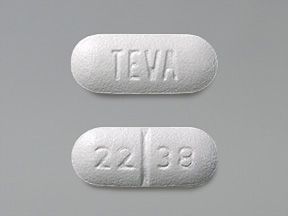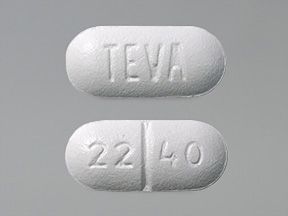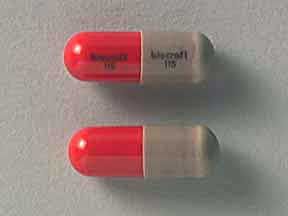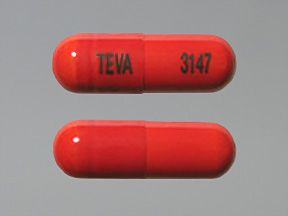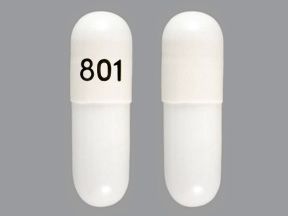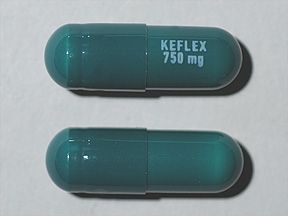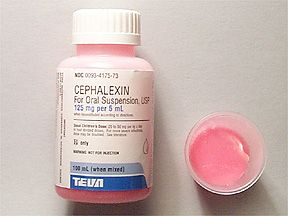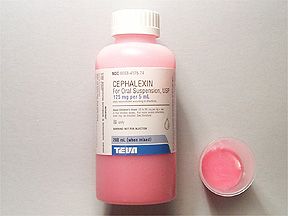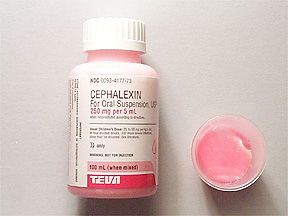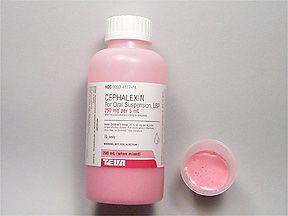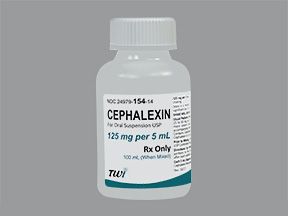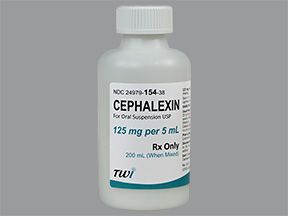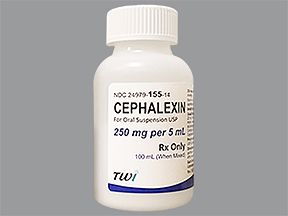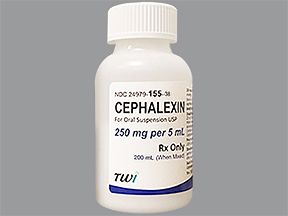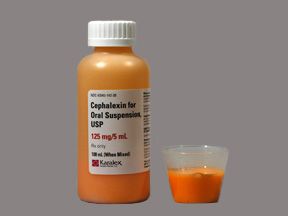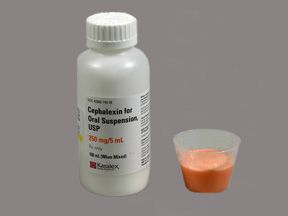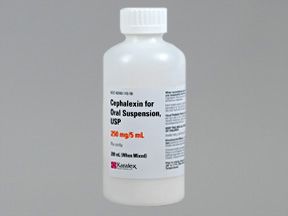- Cephalexin oral capsule is available as a generic drug and as a brand-name drug. Brand name: Keflex.
- Cephalexin also comes as a tablet or liquid suspension that you take by mouth.
- Cephalexin oral capsule is used to treat certain infections caused by bacteria.
- Allergy to β-lactam medications warning: If you’re allergic to β-lactam medications, many of which are antibiotics, you should not take this drug. You could have a serious allergic reaction.
- Antibiotic-associated diarrhea warning: The use of almost all antibiotics, including cephalexin, can cause a reaction that leads to diarrhea. In addition to diarrhea, this reaction can cause severe inflammation of your colon. Severe cases of this reaction can be fatal (cause death). Call your doctor if you have diarrhea while taking or after taking this drug.
Cephalexin oral capsule is a prescription drug that’s available as the brand-name drug Keflex and as a generic drug. Generic drugs usually cost less than the brand-name version. In some cases, they may not be available in all strengths or forms as the brand-name drug.
Cephalexin also comes as an oral tablet and an oral suspension.
Why it’s used
Cephalexin is used to treat certain infections caused by bacteria. These infections include:
- respiratory tract infections
- otitis media (middle ear infections)
- skin and skin structure infections
- bone infections
- genitourinary (urinary tract) infections
How it works
Cephalexin belongs to a class of drugs called cephalosporins (antibiotics). A class of drugs is a group of medications that work in a similar way. These drugs are often used to treat similar conditions.
Cephalexin works by interfering with the formation of the bacteria’s cell walls. This ruptures the walls and kills the bacteria.
This drug should only be used to treat bacterial infections. You should not use it to treat viruses, such as the common cold.
Cephalexin oral capsule doesn’t cause drowsiness. However, it can cause other side effects.
More common side effects
The more common side effects of cephalexin oral capsule include:
- diarrhea
- indigestion
- irritation or inflammation of your stomach lining
- stomach pain
If these effects are mild, they may go away within a few days or a couple of weeks. If they’re more severe or don’t go away, talk with your doctor or pharmacist.
Serious side effects
Call your doctor right away if you have serious side effects. Call 911 if your symptoms feel life threatening or if you think you’re having a medical emergency. Serious side effects and their symptoms can include the following:
- Allergic reactions. Symptoms can include:
- hives
- trouble breathing
- swelling of your face, lips, tongue, or throat
Disclaimer: Our goal is to provide you with the most relevant and current information. However, because drugs affect each person differently, we cannot guarantee that this information includes all possible side effects. This information is not a substitute for medical advice. Always discuss possible side effects with a healthcare professional who knows your medical history.
Cephalexin oral capsule can interact with other medications, vitamins, or herbs you may be taking. An interaction is when a substance changes the way a drug works. This can be harmful or prevent the drug from working well.
To help avoid interactions, your doctor should manage all of your medications carefully. Be sure to tell your doctor about all medications, vitamins, or herbs you’re taking. To find out how this drug might interact with something else you’re taking, talk with your doctor or pharmacist.
Examples of drugs that can cause interactions with cephalexin are listed below.
Interactions that increase your risk of side effects
Side effects from cephalexin: Taking cephalexin with certain medications raises your risk of side effects from cephalexin. This is because the amount of cephalexin in your body is increased. An example of these drugs is probenecid.
Side effects from other drugs: Taking cephalexin with certain medications raises your risk of side effects from these drugs. An example of these drugs is metformin. Taking metformin and cephalexin together may cause kidney problems. Your doctor may adjust your dose of metformin to reduce this risk.
Disclaimer: Our goal is to provide you with the most relevant and current information. However, because drugs interact differently in each person, we cannot guarantee that this information includes all possible interactions. This information is not a substitute for medical advice. Always speak with your healthcare professional about possible interactions with all prescription drugs, vitamins, herbs and supplements, and over-the-counter drugs that you are taking.
This drug comes with several warnings.
Allergy warning
Cephalexin can cause a severe allergic reaction. Symptoms can include:
- hives
- trouble breathing
- swelling of your face, lips, tongue, or throat
If you have an allergic reaction, call your doctor or local poison control center right away. If your symptoms are severe, call 911 or go to the nearest emergency room.
Do not take this drug again if you’ve ever had an allergic reaction to it before. Taking it again could be fatal (cause death).
Warnings for certain groups
For people with kidney problems: If you have kidney problems or a history of kidney disease, you may not be able to clear this drug from your body. This may increase the levels of this drug in your body and cause more side effects. Your doctor may adjust your dose if you have kidney disease. Talk with your doctor about whether this drug is safe for you.
For pregnant people: Studies of the drug in pregnant animals have not shown a risk to the fetus. There aren’t enough studies on pregnant people to show the drug poses a risk to the fetus. You may still want to talk with your doctor if you’re pregnant or planning to become pregnant.
For people who are nursing: Cephalexin passes into breast milk and may cause side effects in a child who is breastfed. Talk with your doctor if you are nursing your child. You may need to decide whether to stop nursing or stop taking this medication.
For seniors: The kidneys of older adults may not work as well as they used to. This can cause your body to process drugs more slowly. As a result, more of the drug stays in your body for a longer time. This raises your risk of side effects.
For children: This drug hasn’t been studied in children younger than 1 year of age with respiratory tract, middle ear, skin and skin structure, bone, and urinary tract infections.
This dosage information is for cephalexin oral capsule. All possible dosages and drug forms may not be included here. Your dosage, drug form, and how often you take the drug will depend on:
- your age
- the condition being treated
- how severe your condition is
- other medical conditions you have
- how you react to the first dose
Forms and strengths
Generic: Cephalexin
- Form: Oral capsule
- Strengths: 250 mg, 500 mg, 750 mg
Brand name: Keflex
- Form: Oral capsule
- Strengths: 750 mg
Dosage for respiratory tract infection
Adult dosage (ages 18 to 64 years)
1–4 grams per day taken in divided doses. The usual dose is 250 mg taken every 6 hours, or a dose of 500 mg every 12 hours may be given. If you have a severe infection, your doctor may give you a larger dose.
Child dosage (ages 15 to 17 years)
1–4 grams per day taken in divided doses. The usual dose is 250 mg taken every 6 hours, or a dose of 500 mg every 12 hours may be given. If you have a severe infection, your doctor may give you a larger dose.
Child dosage (ages 1 to 14 years)
25–50 mg/kg of body weight per day taken in divided doses. Your doctor may double your dose for severe infections.
Child dosage (ages 0 to 1 years)
This medication hasn’t been studied in children younger than 1 year for this condition.
Senior dosage (ages 65 years and older)
The kidneys of older adults may not work as well as they used to. This can cause your body to process drugs more slowly. As a result, more of a drug stays in your body for a longer time. This raises your risk of side effects. Your doctor may start you on a lowered dose or a different dosing schedule. This can help keep levels of this drug from building up too much in your body.
Dosage for otitis media (middle ear infection)
Adult dosage (ages 18 to 64 years)
1–4 grams per day taken in divided doses. The usual dose is 250 mg taken every 6 hours, or a dose of 500 mg every 12 hours may be given. If you have a severe infection, your doctor may give you a larger dose.
Child dosage (ages 15 to 17 years)
1–4 grams per day taken in divided doses. The usual dose is 250 mg taken every 6 hours, or a dose of 500 mg every 12 hours may be given. If you have a severe infection, your doctor may give you a larger dose.
Child dosage (ages 1 to 14 years)
75–100 mg/kg of body weight per day given in equally divided doses every 6 hours.
Child dosage (ages 0 to 1 years)
This medication hasn’t been studied in children younger than 1 year for this condition.
Senior dosage (ages 65 years and older)
The kidneys of older adults may not work as well as they used to. This can cause your body to process drugs more slowly. As a result, more of a drug stays in your body for a longer time. This raises your risk of side effects. Your doctor may start you on a lowered dose or a different dosing schedule. This can help keep levels of this drug from building up too much in your body.
Dosage for skin and skin structure infection
Adult dosage (ages 18 to 64 years)
1–4 grams per day taken in divided doses. The usual dose is 250 mg taken every 6 hours, or a dose of 500 mg every 12 hours may be given. If you have a severe infection, your doctor may give you a larger dose.
Child dosage (ages 15 to 17 years)
1–4 grams per day taken in divided doses. The usual dose is 250 mg taken every 6 hours, or a dose of 500 mg every 12 hours may be given. If you have a severe infection, your doctor may give you a larger dose.
Child dosage (ages 1 to 14 years)
25–50 mg/kg of body weight per day taken in divided doses. Your doctor may double your dose for severe infections.
Child dosage (ages 0 to 1 years)
This medication hasn’t been studied in children younger than 1 year for this condition.
Senior dosage (ages 65 years and older)
The kidneys of older adults may not work as well as they used to. This can cause your body to process drugs more slowly. As a result, more of a drug stays in your body for a longer time. This raises your risk of side effects. Your doctor may start you on a lowered dose or a different dosing schedule. This can help keep levels of this drug from building up too much in your body.
Dosage for bone infections
Adult dosage (ages 18 to 64 years)
1–4 grams per day taken in divided doses. The usual dose is 250 mg taken every 6 hours, or a dose of 500 mg every 12 hours may be given. If you have a severe infection, your doctor may give you a larger dose.
Child dosage (ages 15 to 17 years)
1–4 grams per day taken in divided doses. The usual dose is 250 mg taken every 6 hours, or a dose of 500 mg every 12 hours may be given. If you have a severe infection, your doctor may give you a larger dose.
Child dosage (ages 1 to 14 years)
25–50 mg/kg of body weight per day taken in divided doses. Your doctor may double your dose for severe infections.
Child dosage (ages 0 to 1 years)
This medication hasn’t been studied in children younger than 1 year for this condition.
Senior dosage (ages 65 years and older)
The kidneys of older adults may not work as well as they used to. This can cause your body to process drugs more slowly. As a result, more of a drug stays in your body for a longer time. This raises your risk of side effects. Your doctor may start you on a lowered dose or a different dosing schedule. This can help keep levels of this drug from building up too much in your body.
Dosage for genitourinary (urinary tract) infection
Adult dosage (ages 18 to 64 years)
1–4 grams per day taken in divided doses. The usual dose is 250 mg taken every 6 hours, or a dose of 500 mg every 12 hours may be given. Your doctor may give you a larger dose if you have a severe infection.
Child dosage (ages 15 to 17 years)
1–4 grams per day taken in divided doses. The usual dose is 250 mg taken every 6 hours, or a dose of 500 mg every 12 hours may be given. Your doctor may give you a larger dose if you have a severe infection.
Child dosage (ages 1 to 14 years)
25–50 mg/kg of body weight per day taken in divided doses. Your doctor may double your dose for severe infections.
Child dosage (ages 0 to 1 years)
This medication hasn’t been studied in children younger than 1 year for this condition.
Senior dosage (ages 65 years and older)
The kidneys of older adults may not work as well as they used to. This can cause your body to process drugs more slowly. As a result, more of a drug stays in your body for a longer time. This raises your risk of side effects. Your doctor may start you on a lowered dose or a different dosing schedule. This can help keep levels of this drug from building up too much in your body.
Special dosage considerations
For adults and children (15 years of age and older) with kidney problems:
- People with a creatinine clearance (CrCL) of 30–59 mL/min: maximum daily dose should not exceed 1 g
- People with a CrCL of 15 to 29 mL/min: 250 mg taken every 8 or 12 hours
- People with a CrCL of 5 to 14 mL/min: 250 mg every 24 hours
- People with a CrCL of 1 to 4 mL/min: 250 mg every 48 or 60 hours
Disclaimer: Our goal is to provide you with the most relevant and current information. However, because drugs affect each person differently, we cannot guarantee that this list includes all possible dosages. This information is not a substitute for medical advice. Always speak with your doctor or pharmacist about dosages that are right for you.
Cephalexin oral capsule is a short-term drug treatment. It comes with risks if you don’t take it as prescribed.
If you stop taking the drug or don’t take it at all: If you don’t take this drug, your infection may not improve, or it may get worse.
If you miss doses or don’t take the drug on schedule: Your medication may not work as well or may stop working completely. For this drug to work well, a certain amount needs to be in your body at all times.
If you take too much: You could have dangerous levels of this drug in your body. Symptoms may include:
- nausea
- vomiting
- stomach aches
- diarrhea
- blood in your urine
If you think you’ve taken too much of this drug, act right away. Call your doctor or local Poison Control Center, or go to the nearest emergency room.
What to do if you miss a dose: Take your dose as soon as you remember. But if you remember just a few hours before your next scheduled dose, take only one dose. Never try to catch up by taking two doses at once. This could result in dangerous side effects.
How to tell if the drug is working: Your symptoms and your infection should go away if this drug is working.
Keep these considerations in mind if your doctor prescribes cephalexin oral capsule for you.
General
You can take cephalexin with or without food.
Storage
- Store the capsules between 59°F and 86°F (15°C and 30°C).
- Don’t store this medication in moist or damp areas, such as bathrooms.
Refills
A prescription for this medication is refillable. You should not need a new prescription for this medication to be refilled. Your doctor will write the number of refills authorized on your prescription.
Travel
When traveling with your medication:
- Always carry your medication with you. When flying, never put it into a checked bag. Keep it in your carry-on bag.
- Don’t worry about airport X-ray machines. They can’t hurt your medication.
- You may need to show airport staff the pharmacy label for your medication. Always carry the original prescription-labeled box with you.
- Don’t put this medication in your car’s glove compartment or leave it in the car. Be sure to avoid doing this when the weather is very hot or very cold.
Clinical monitoring
Your doctor may do blood tests to check how well your kidneys are working. If your kidneys aren’t working well, your doctor may lower your dose of this drug.
There are other drugs available to treat your condition. Some may be better suited for you than others. Talk with your doctor about other drug options that may work for you.
Disclaimer: Medical News Today has made every effort to make certain that all information is factually correct, comprehensive, and up to date. However, this article should not be used as a substitute for the knowledge and expertise of a licensed healthcare professional. You should always consult your doctor or another healthcare professional before taking any medication. The drug information contained herein is subject to change and is not intended to cover all possible uses, directions, precautions, warnings, drug interactions, allergic reactions, or adverse effects. The absence of warnings or other information for a given drug does not indicate that the drug or drug combination is safe, effective, or appropriate for all patients or all specific uses.

